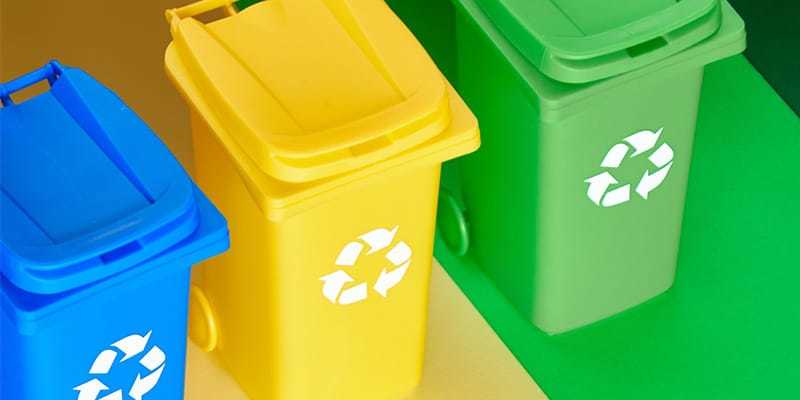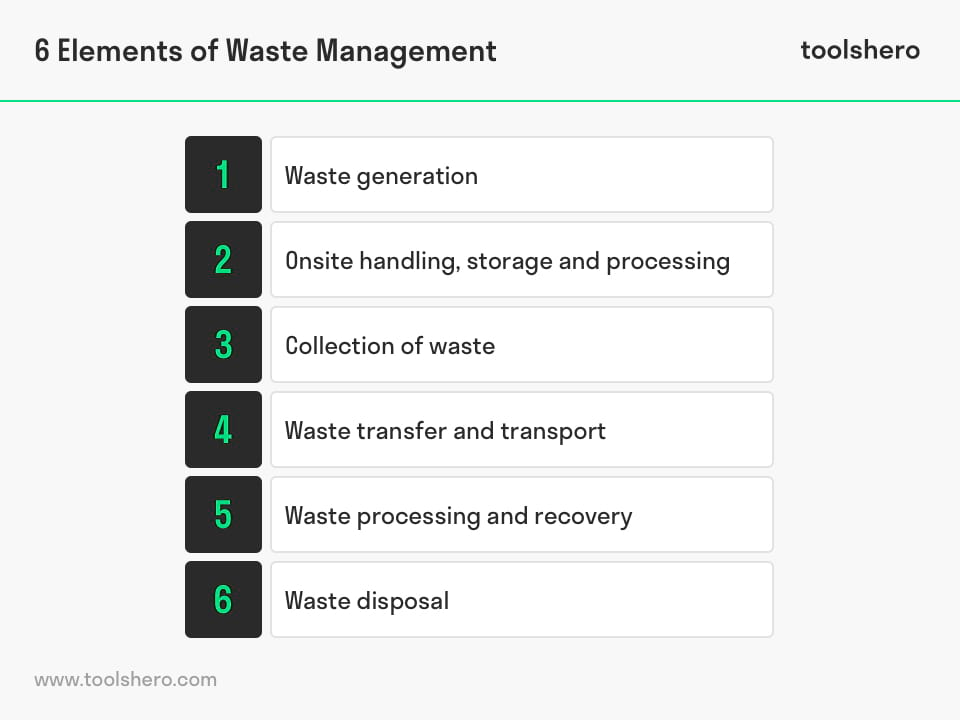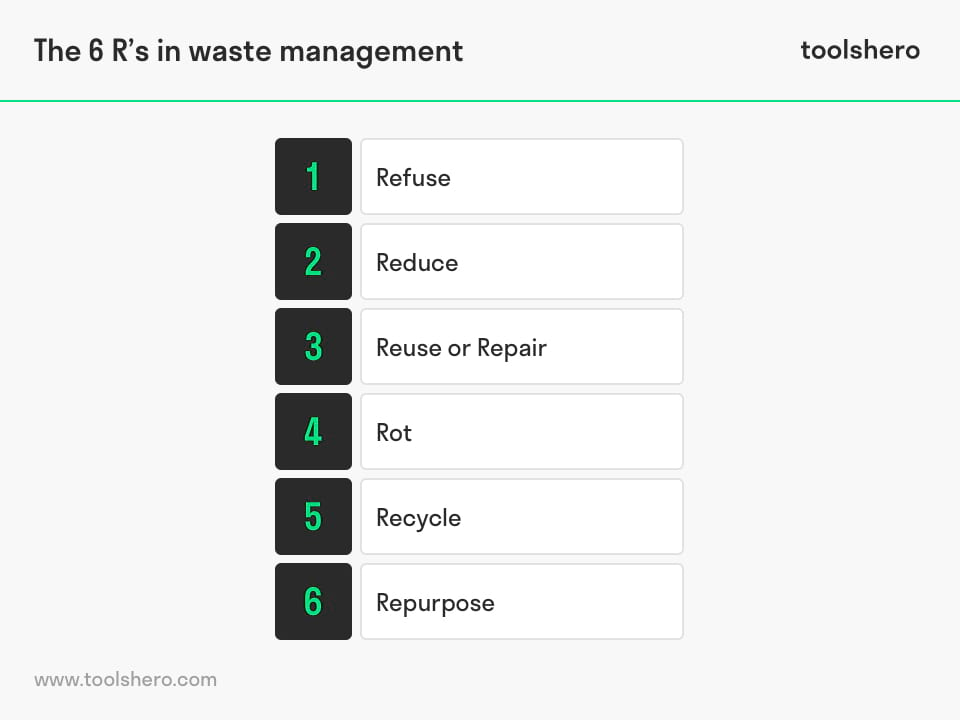Waste Management explained

Waste Management: this article provides a practical explanation of waste management. In addition to the meaning, this article also explains the six elements, the relationship with waste generation, methods of waste disposal and the six keywords. After reading you will understand the basics of this management strategy. Have fun reading!
What is Waste Management? The definition
Waste management can be defined as all the activities that are required to manage waste from the point of collecting the waste to recycling and monitoring.
Waste in waste management refers to unwanted or unusable material that is produced through the activity of humans and can have different forms. Waste can be liquid, solid, or gas with each having its disposal method and way of managing the waste.
Besides the state of the matter, there are also different types of waste, such as household, biological, commercial and industrial waste. Some types of waste can form a threat to the environment and human health, such as radioactive and chemical waste. These types of waste are called hazardous waste.
The aim of waste management is to reduce the dangerous effects of such waste on the environment and human health. A big part of waste management deals with municipal solid waste, which is created by industrial, commercial, and household activity.
History of Waste Management
The amount of waste that is being produced by humans has changed throughout history. In Europe, a sudden increase was a result of industrialisation, together with the growth in urban population. Due to a lack of clearance regulations, the waste in the streets started to pile up and affect the hygiene and health of the urban populations.
After cholera outbreaks in England during the mid-19th century, social reformer Edwin Chadwick published a report on ‘The Sanitary Condition of the Labouring Population’. In this report, he wrote about the need for effective waste removal and management facilities to improve the population’s health and wellbeing.
This led to the ‘Nuisance Removal and Disease Prevention Act’ in 1846. Followed by this act, the Public Health Act 1975 was introduced and it became compulsory for households to use a ‘dust-bin’ for the weekly disposal of their waste.
A sudden increase in waste for disposal was followed by the creation of incineration plants, created for the destruction of waste. At the beginning of the 20th century, similar waste systems were being adapted by other cities in Europe and Northern America.
However, waste management nowadays is not the same in every country, region or can even vary among different sectors such as the industrial and residential sector.
6 Elements of Waste Management
Waste management consists of 6 elements and activities:

Figure 1 – 6 elements of Waste management
Waste generation
Waste generation involves all the activities that identify if materials are no longer usable and if they can be used for systematic disposal.
Onsite handling, storage and processing
After waste generation, there are activities to facilitate easier collection of the waste, such as the use of dust bins and putting them at places where most waste is being generated.
Collection of waste
Another phase of waste management is collecting waste. This, for example, includes the placement of waste collection bins, collecting the waste by vehicles and making sure the vehicles get to the right location where they are emptied.
Waste transfer and transport
Waste transfer and transport is the part of waste management where the focus is on all the activities involved in getting waste from the smaller waste collection locations to the bigger regional waste disposal stations. Crucial for transportation is the availability of waste transport vehicles.
Waste processing and recovery
This part involves the facilities, techniques and equipment that are needed to recover and recycle materials from the waste process. This part is also to improve the effectiveness of the other elements and activities in waste management.
Waste disposal
Waste disposal is the final step in waste management and involves all the activities that are needed for systematic disposal. In the following part, you’ll read about the different methods of waste disposal.
Methods of Waste Disposal
In this part, you will read about some of the most used methods of waste disposal within waste management.
Landfills
One of the most popular methods used for waste disposal nowadays is throwing waste in landfills. In this process, waste is being buried in the land. This method is commonly used in the southern hemisphere and eliminates bad odours.
This method also reduces health risks and other dangers caused by waste laying around on the streets. Using the landfills method does require some space and due to a lack of space in some places, this method is being used less as a form of waste management these days.
Also, placing waste in the ground can produce methane and other gasses formed by the landfills method. These gases can be harmful to the environment. They can cause air and water pollution, and affect the health of humans and animals. These disadvantages led to areas reconsidering the use of landfills in waste management.
Incineration
Another waste disposal method used in waste management is incineration, also known as combustion. With the incineration method, municipal solid waste is being burned at high temperatures. This process turns waste into gaseous products and other remaining materials.
An advantage of incineration, as opposed to the landfills method, is that it reduces the volume of waste up to 30 per cent. This way space that is taken up by waste is reduced and it offers an alternative for landfills. This is why incineration is popular in areas where they ran out of space for landfills.
Plasma gasification
Another form of waste management is plasma gasification. Plasma is an electrically charged gas and with this method, plasma is being used to convert solid or liquid waste into syngas. The waste is being heated, melted and then being transformed into gas.
Plasma gasification is mostly used for the disposal of commercial, industrial waste and hazardous waste. Compared to other methods such as landfills, the initial investment costs and operational costs are relatively high. Advantages of this method of waste disposal are, that it creates renewable energy and that it results in less harmful emissions.
Composting
Composting is a waste management method and is a natural process that speeds up the decay of organic materials such as the remains of kitchen, plants and garden waste. Vital to the process are microorganisms and for these microorganisms to thrive, it’s important to create an ideal environment such as the right temperatures, moisture and enough oxygen.
The end-product of this process is nutrient-rich soil, which is being used for the growth of crops, plants and trees. Composting is often used for organic farming. Composting is a relatively safe method for waste disposal and can easily be used for waste management on a household level. A disadvantage could be that because it’s a natural process it does take some time and like landfills, this method requires a lot of space.
Recycling and Recovery
Recycling is a process in which waste is being converted into new products. Recycling is intended to reduce energy usage, reduce the use of new raw materials and therefore preserve natural resources. Also what it does is reduce the use of landfills, reduce water and air pollution, and reduce the emission of different types of harmful gasses.
Recycling is part of recourse recovery in which the extraction of natural sources are minimized and the focus of designing a product or material is on sustainability, durability, reuse and recycling.
The 6 R’s in waste management
In the late 1970s the 3 Rs, that stands for ‘reduce’, ‘reuse’, and ‘recycle’, were introduced to give the public a guideline for reducing waste. The goal was to reduce North Americans’ waste production and to help the governments’ ability to manage waste.
In 2013, writer Bea Johnson published her book Zero Waste Home: The Ultimate Guide to Simplify Your Life by Reducing Your Waste. In this book, she added two more Rs to the list, Rot and Refuse. She presented the five Rs as a framework to produce as less waste as possible. Her goal is to help households and businesses to recognize the habits that lead them to produce more waste.

Figure 2 – 6 R’s in waste management
Refuse in Waste Management
Refusing is about eliminating waste from the beginning and declining offers for free stuff that would result in instant waste. People are advised to refuse free stuff such as coupons, flyers and magazines, and are stimulated to find reusable alternatives for waste such as single-use plastics.
This can also be incorporated into a company’s business strategy. Refusing to buy non-recyclable products can be a strategy, but also refusing unnecessary packaging from vendors.
Reduce in Waste Management
Reduce stands for reducing what is being purchased and being aware of what it is you need and what you want. This goes together with refusing. What also helps is purchasing products of the best quality, because they will last longer and will reduce the times you’ll need to purchase that product. Also maintaining the products and materials you have to make them last longer.
Reuse or Repair in Waste Management
Before throwing away something and replacing it by a new one, households and businesses are advised to first see if they can reuse or repair it. This can be the case with for example devices, clothing and furniture. Employers can stimulate employees to reuse items, limit the amount of waste that’s being produced while also saving money.
Reusing also includes donating or selling used products instead of throwing them away. Also buying used products yourself is a way to reuse someone else’s items.
Rot in Waste Management
Rot stands for composing, which is also a way of reducing the amount of waste. Composing does take some time and space as I’ve mentioned before and that’s why there are alternative ways of composing. In some cities, there are composting drop-off spots or even pick-up services.
Recycle in Waste Management
As a last resort, there is recycling. If you have to throw away something, then recycling is known for being the most environmentally friendly method for waste disposal. Recycling at the household or business level means throwing away materials such as cardboard, plastics, glass and aluminium separated from each other.
Repurpose in Waste Management
An additional R, Repurpose, is also used when it comes to producing less waste. Repurpose is also known as upcycling and refers to using one item for multiple purposes. This does require some creativity. An example is using wasted printer paper as scrap paper or using cardboard boxes from previous deliveries for storing other supplies.
Now it’s your turn
What do you think? Do you recognise the explanation of waste management? Which waste management methods are you familiar with? How is the disposal of waste being managed where you live? Do you agree with the way it’s being done? What could you do to minimise your own or your company’s waste production?
Share your experience and knowledge in the comments box below.
More information
- Hoornweg, D., & Bhada-Tata, P. (2012). What a waste: a global review of solid waste management.
- Kreith, F. (1999). Handbook of solid waste management.
- Kaza, S., Yao, L., Bhada-Tata, P., & Van Woerden, F. (2018). What a waste 2.0: a global snapshot of solid waste management to 2050. The World Bank.
- White, P., Dranke, M., & Hindle, P. (2012). Integrated solid waste management: a lifecycle inventory. Springer Science & Business Media.
How to cite this article:
Van Velden, E. (2020). Waste Management. Retrieved [insert date] from Toolshero: https://www.toolshero.com/management/waste-management/
Original publication date: 06/20/2020 | Last update: 09/13/2023
Add a link to this page on your website:
<a href=”https://www.toolshero.com/management/waste-management/”>Toolshero: Waste Management</a>











